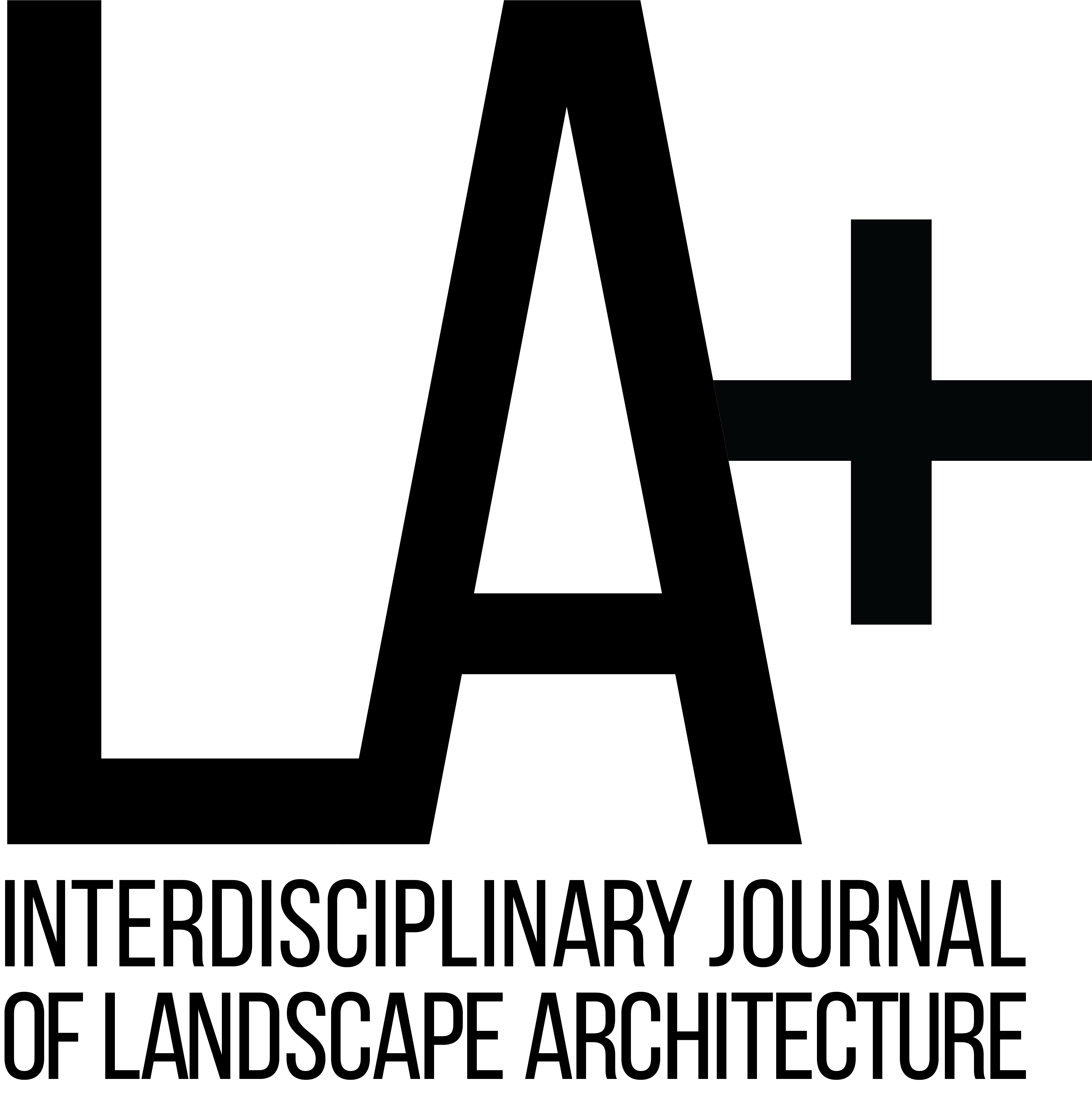WINNNG ENTRIES
The following five entries from Australia, China, the UK, and the USA were declared winners by the LA+ ICONOCLAST jury. Each winning entry will receive $4,000 in prize money plus feature publication in LA+ Journal’s forthcoming LA+ ICONOCLAST issue (out Fall 2019).
Tiago Torres-Campos
Edinburgh, UK



THE GEOSCRAPER OF THE CAPTIVE BIOMES
Looking Back: One Hundred Years After the Eco-Terrorist Attack
New York: April 23, 2118
On this day, one hundred years ago, Central Park’s vegetation was suddenly wiped out. In a few days, one of the world’s most cherished landscapes disappeared without a trace. The Gaians were extremely violent in drawing attention to the planetary destruction we were causing.
Periods of mourning following brutal attacks are often pivotal in the collective lives of cities. They are times of grief, sorrow, and absence, just as they are times of rebirth, hope, and reconstruction. Above all, they bring about great, meaningful transformation.
Soon after the incident, the temptation to grid over the park was tremendous. The temptation to relocate the green lung elsewhere was even bigger. Yet we resisted. Looking back, we can proudly say that the “Geoscraper” – the Park’s affectionate nickname has remained what it had been since its inception on the city grid. Or has it? Instead of acting like a drawing master, the appointed landscape architect diverged from the designs of the Park’s founding fathers. While they restaged a state of virgin nature in the form of a 19th-century picturesque park, the landscape curator reignited a 40-year-old idea of that landscape as a giant horizontal skyscraper. From an Arcadian synthetic carpet, the Geoscraper evolved into a performative landscape machine whose first function was to capture the Earth’s biomes. These were then converted into a landscape program where alternative social and ecological values and functions were forced to coexist. Building upon the Park’s previous role as the center of one of the world’s centers, the Geoscraper also became an active place for geo-eco-bio-social experimentation.
On this day, 70 years ago, I was born in one of the Park’s temporary housing pods. My family shared a plot where we produced our food. On festive days, we all gathered in the big collective kitchen. I learned how to swim in the summer and ice skate in the winter. The Geoscraper taught me about biology, ecology, science, and the arts. It taught me about people. A forest-city in the center of New York where I found my way to becoming an advocate for Earth. Every day I stand up for biomes, ecosystems, species, and individuals in the Earth Parliament. I’m fierce with the critics who question whether we are asking too much of this park. I don’t think they see that this is also a landscape that slows us down and attunes us to gentle practices of noticing and making sense of the world. On this day, 100 years ago, the brutal eco-massacre also opened up a crucial door into rethinking our human relations with other entities with whom we share our home planet. Maybe now we will be able to carry this lesson forward as part of the human project into the other rocky planets.
John Beckmann, Hannah
LaSota + Laeticia Hervy
Axis Mundi Design – New York,
USA
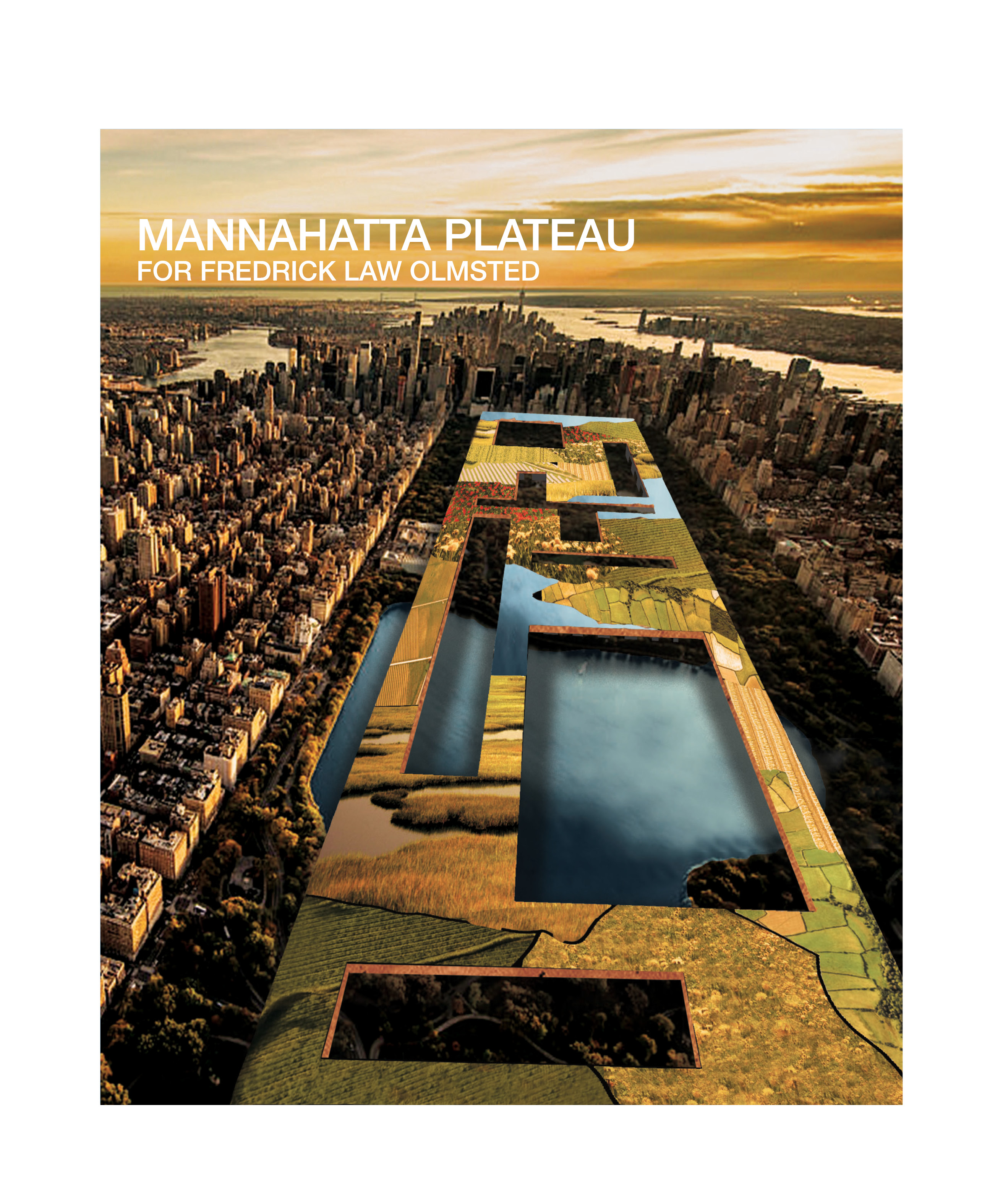
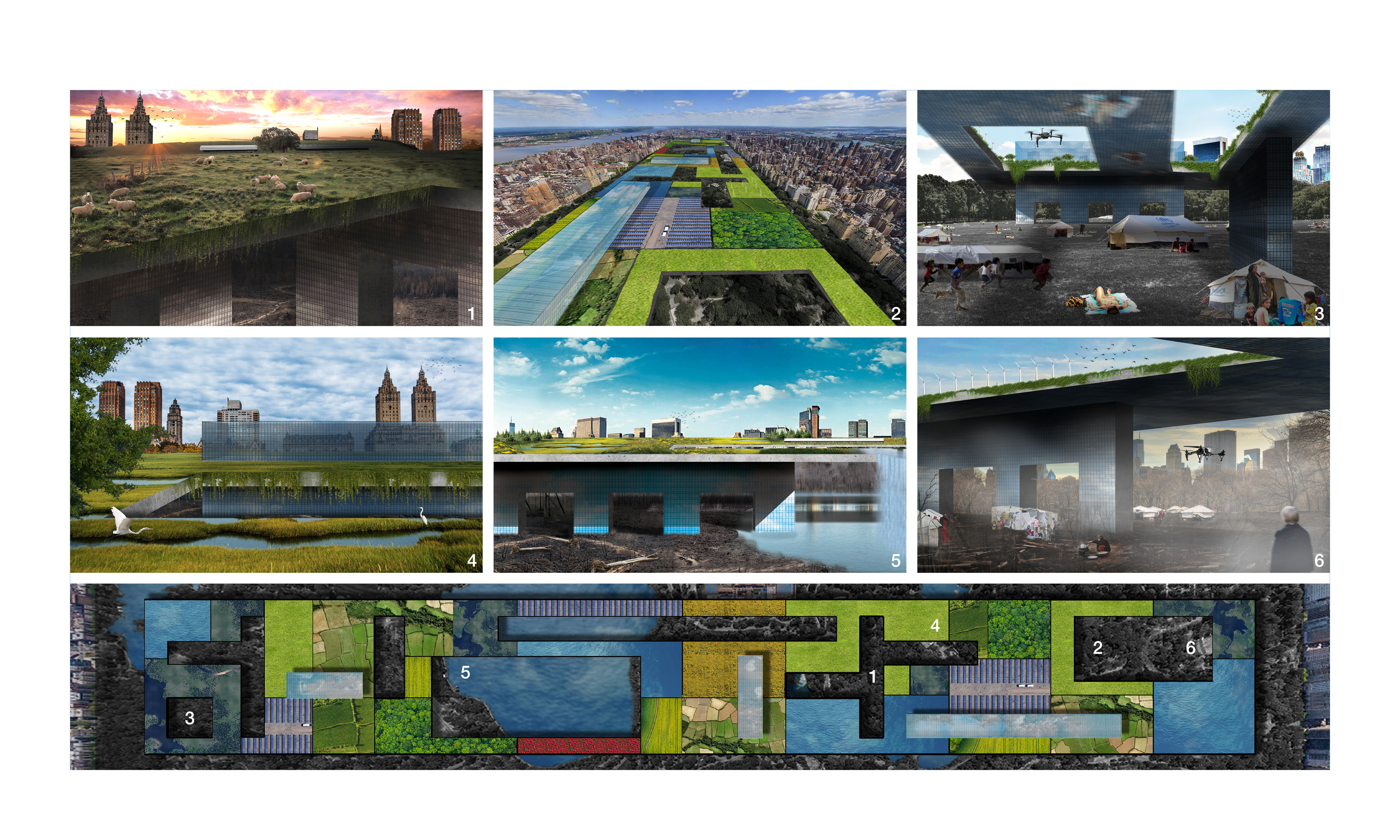
MANNAHATTA PLATEAU FOR FREDRICK LAW OLMSTED
A Re-Enchantment for a Post-Apocalyptic Ecology
“Reality is not always probable, or likely.”— Jorge Luis Borges
The MANNAHATTA PLATEAU presents a dynamic ecological vision of nature integrated with urbanism. The ravaged original surface of Central Park is left as a regenerating wilderness, a temple to the raw power of nature. Built over it is a green mega-structure, a plateau that supports a raised parkland consisting of a patchwork of abundantly diverse interconnecting environmental zones. The bold, linear aesthetic of the plateau offers a new perspective upon the wilderness that lies partially revealed beneath its cut-out surface. The 200-foot-high structure is inscribed by the lines and scale of the city itself – the typical Manhattan building lot (25 x 100 ft) serves as the basic modular. The street grid is celebrated by being projected across the park’s surface, yet the rigid geometry of urban forms is broken down into subsections defined by the flowing lines of nature. In addition, supporting structures containing vertical circulation are clad in glass that directs light back onto the dystopic landscape below, whilst optically blurring the distinction between nature and architecture.
The plateau is infused with plants native to the region to re-establish the island of “Mannahatta” prior to the Dutch colonization. These plants form the basis of wild meadows, wetlands, wildlife refuges, and insect habitats. Sustainable agricultural zones—including hydroponic farming enabled by rainwater harvesting—feature hanging gardens of local species of fruits and vegetables pollinated by nearby bee colonies. The plateau also foregrounds renewable energy sources, such as solar tiles, Wattway pathways (solar roads), and windmills oriented toward the prevailing wind.
The aesthetic of the plateau manifests an underlying conceptual scheme. As with Gilles Deleuze’s A Thousand Plateaus, this structure allows us to envision the conception of the plateau as a patchwork of dynamic juxtapositions that foster endless new connections. Unexpected juxtapositions and extensive circulation pathways are created between diverse zones for theater, cinema, music, visual arts, and local history, as well as activities such as hiking, swimming, and ice skating.
The MANNAHATTA PLATEAU uses its aesthetic to bring the diverse elements of nature and urban design into dynamic coexistence. As this project matures, new organic connections and cross-pollinations will occur between the revived Mannahatta plateau and the unplanned wilderness of Central Park beneath, creating a new ecological future from two versions of the past.
Chuanfei Yu, Jiaqi
Wang + Huiwen Shi
South East University –
Nanjing, China
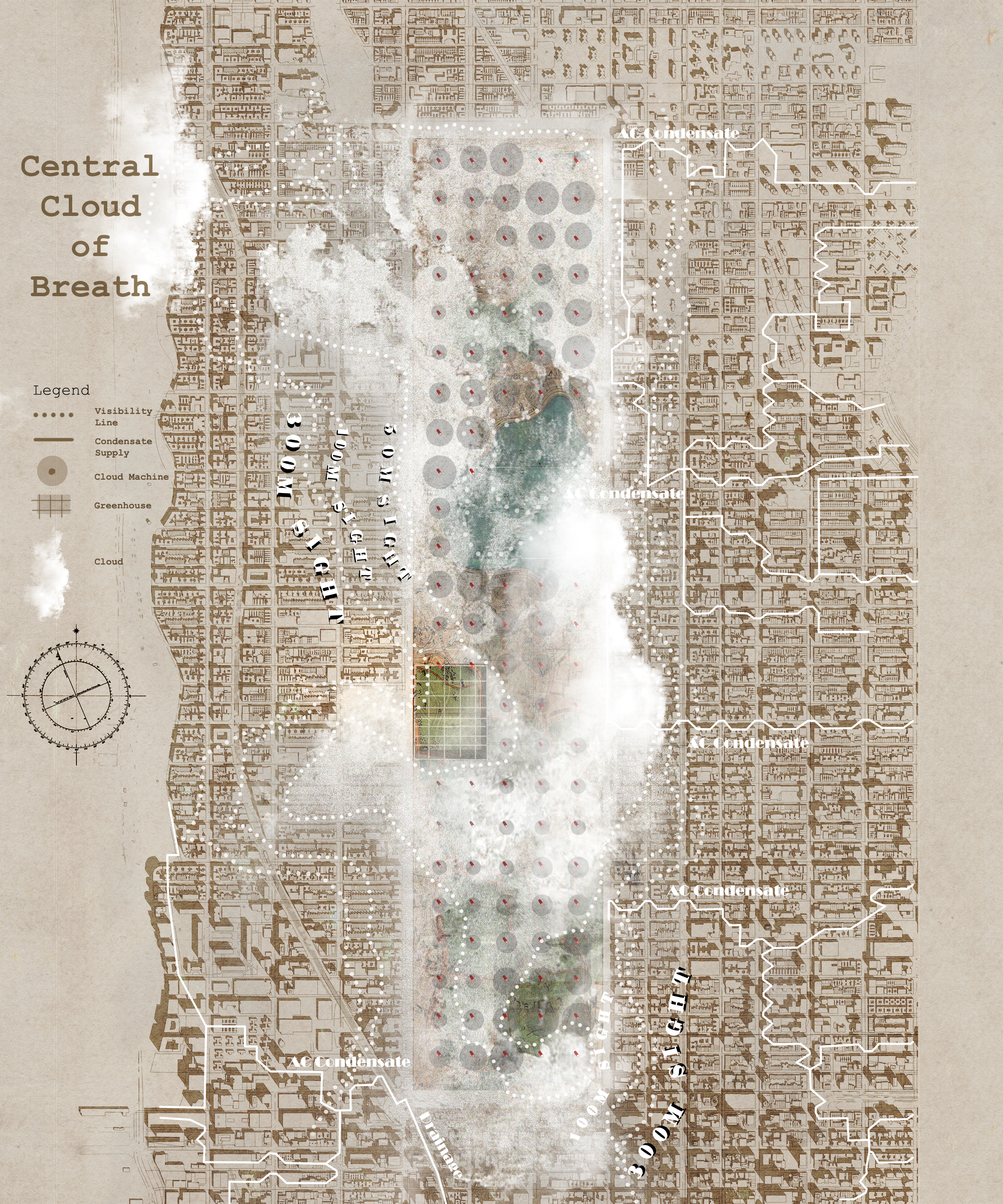

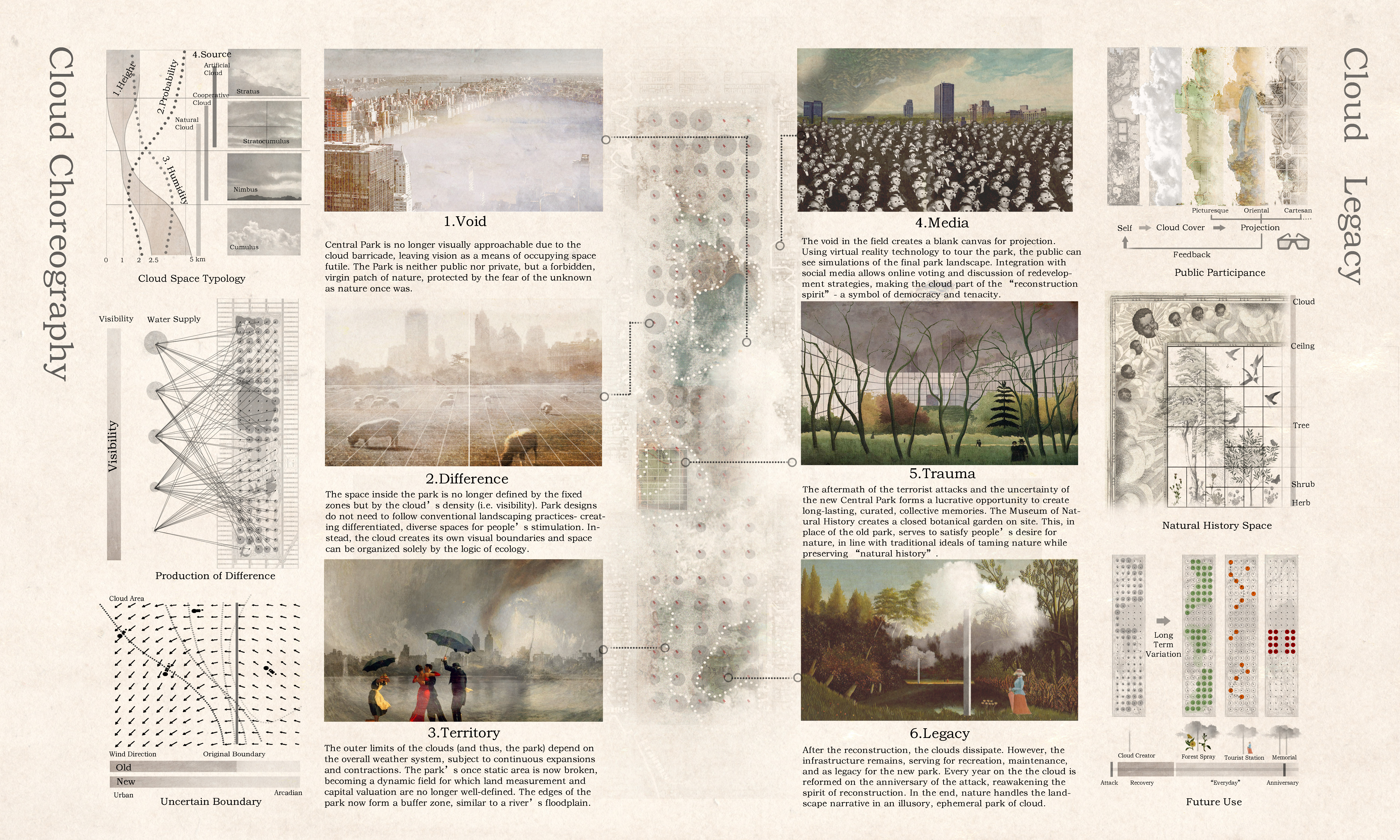
The disenchantment of weather/cloud is a result of the rationalization project of nature since the 19th century, Central Park being one of its prime achievements. As the terrorist attack broke the old narrative of an everlasting Arcadian park, the best way ofreconstruction is to restore a place of uncertainty – cloud space.
After the terrorist attack, Central Park lost all of its trees, causing the microclimate to change dramatically. The increase in evaporation due to the loss of the tree cover poses a problem for any reconstruction idea. Our short-term plan proposes creating a layer of cloud over the Park. The layer—meant to decrease the evaporation of water and protect the reconstruction of the ecosystem—will be created and maintained by artificial-cloud infrastructure. Water used in the plan will come from the AC condensate of Manhattan office buildings – essentially the water vapor exhaled by people. In this way, every New Yorker is part of the great “Breathe to Save Central Park” plan.
In the meantime, the cloud layer broke the myth of a tamed nature, creating new landscape narratives. The illusory nature of the clouds differs from the classic view of Central Park, picturesque and everlasting. The fixed boundaries and subdivisions are gone, and so is the narrative of occupying and capitalizing the landscape via vision. Visibility now defines the boundary between the city and nature, subject to the overall weather system. Public nostalgia for the past is appeased by a greenhouse garden, which preserves examples of the original plants and serves as a museum for visitors.
After reconstruction, the clouds would dissipate but the infrastructure would remain as a legacy of the New Central Park, serving occasionally for recreation or maintenance. Cloud production will be reactivated on the anniversary of the attack to awaken the memories of reconstruction. In those moments, weather handles landscape narrative again, in an illusory, ephemeral park of cloud.
Joe Rowling, Nick
McLeod + Javier Arcila
e8urban – Sydney, Australia
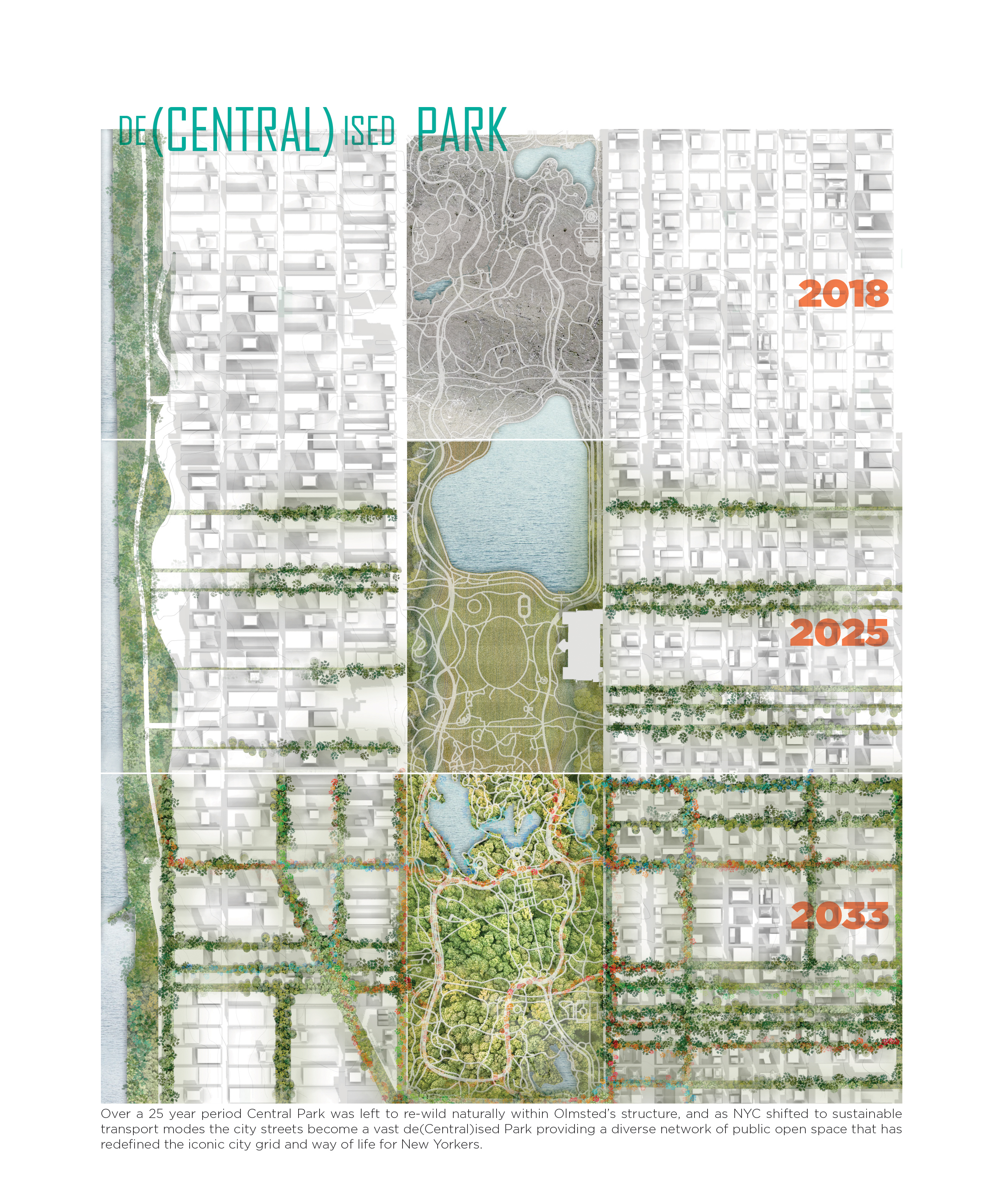


Following the 2018 eco-terrorist attack on Central Park, New York City authorities—acknowledging the public’s concern about the depletion of global resources—embarked on a radical program to reduce the city’s environmental footprint. It was decreed that Central Park would be encouraged to rewild naturally within the existing structure of Olmsted’s Central Park masterplan. Furthermore, it was decreed that by 2033 all vehicles within Manhattan would be electric with ride-sharing incentivized. This bold move had the result of freeing up a vast area of formerly car-dominated public space, namely vehicle carriageways, which the city converted into new urban parklands with an area twice the size of the original Central Park – a new de(Central)ized Park.
This ambitious plan implemented over a 25-year period saw almost 75% of the streets within Manhattan replanned with vastly reduced roadways, dedicated cycleways, and new diverse open-space ribbons and dwelling spaces radiating out across New York City. Recreational activities that were once isolated to Central Park have been distributed to the new expanded green links designed into the streets. Through the de(Central)ized Park framework over half a million new street trees have been planted across New York City, extending the urban canopy and contributing to climatic cooling of the city. Sports and fitness loops and stations wind around city streets and new cycle routes mean that now over 80% of city school students cycle to class every day! The new urban canopy has created ecological corridors through the city, and a comprehensive water collection and treatment system means that all urban stormwater run-off is cleaned, then either reused or diverted into the Hudson River.
At the heart of this grand plan has been a wider social initiative, democratizing Manhattan’s open space areas. Where once only a handful enjoyed a view over Central Park, now from Washington Heights to Tribeca almost every resident in New York City can look out of their window onto a little piece of the new de(Central)ized Park.
Song Zhang + Minzhi
Lin
Song + Minzhi – Shanghai, China
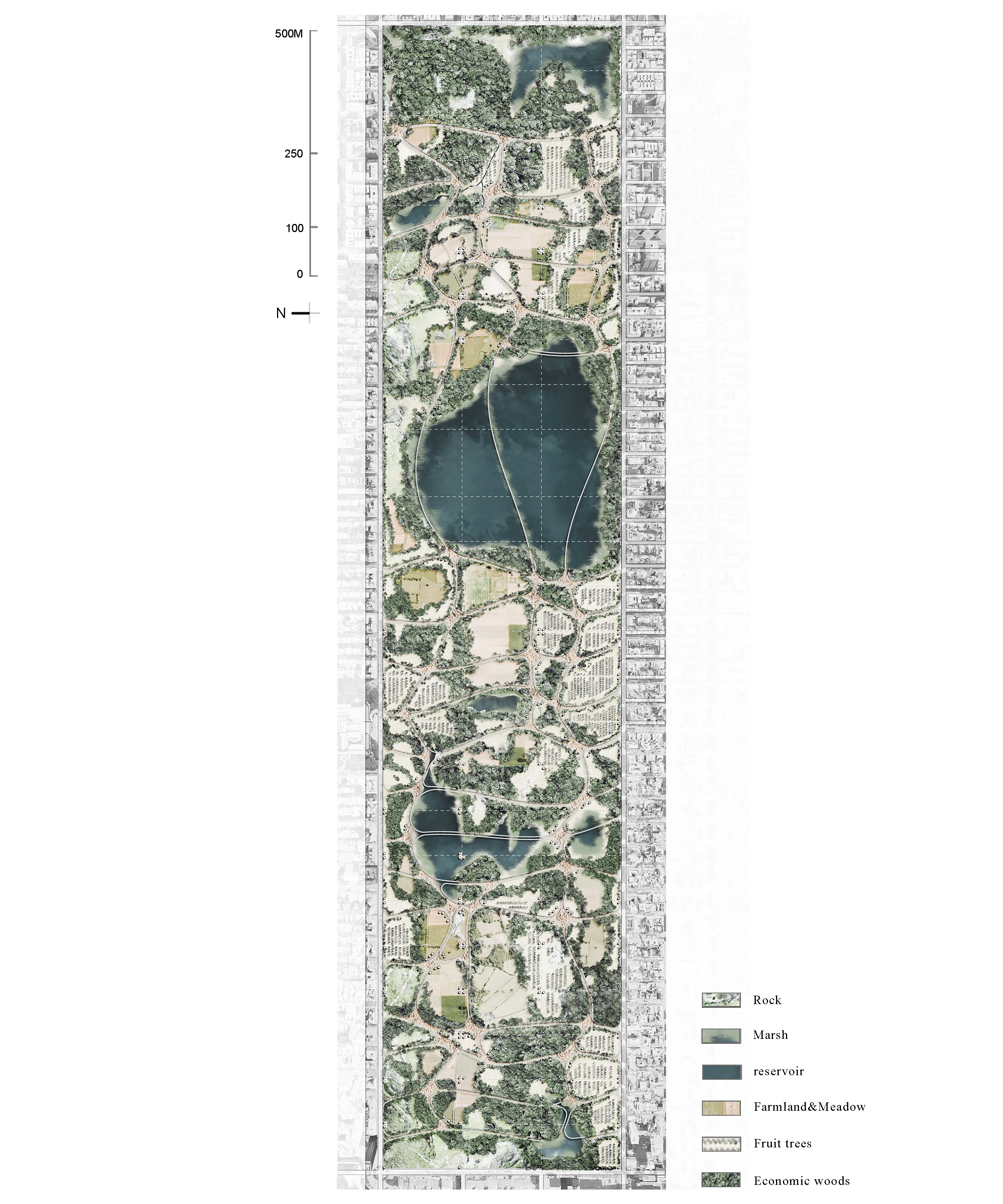
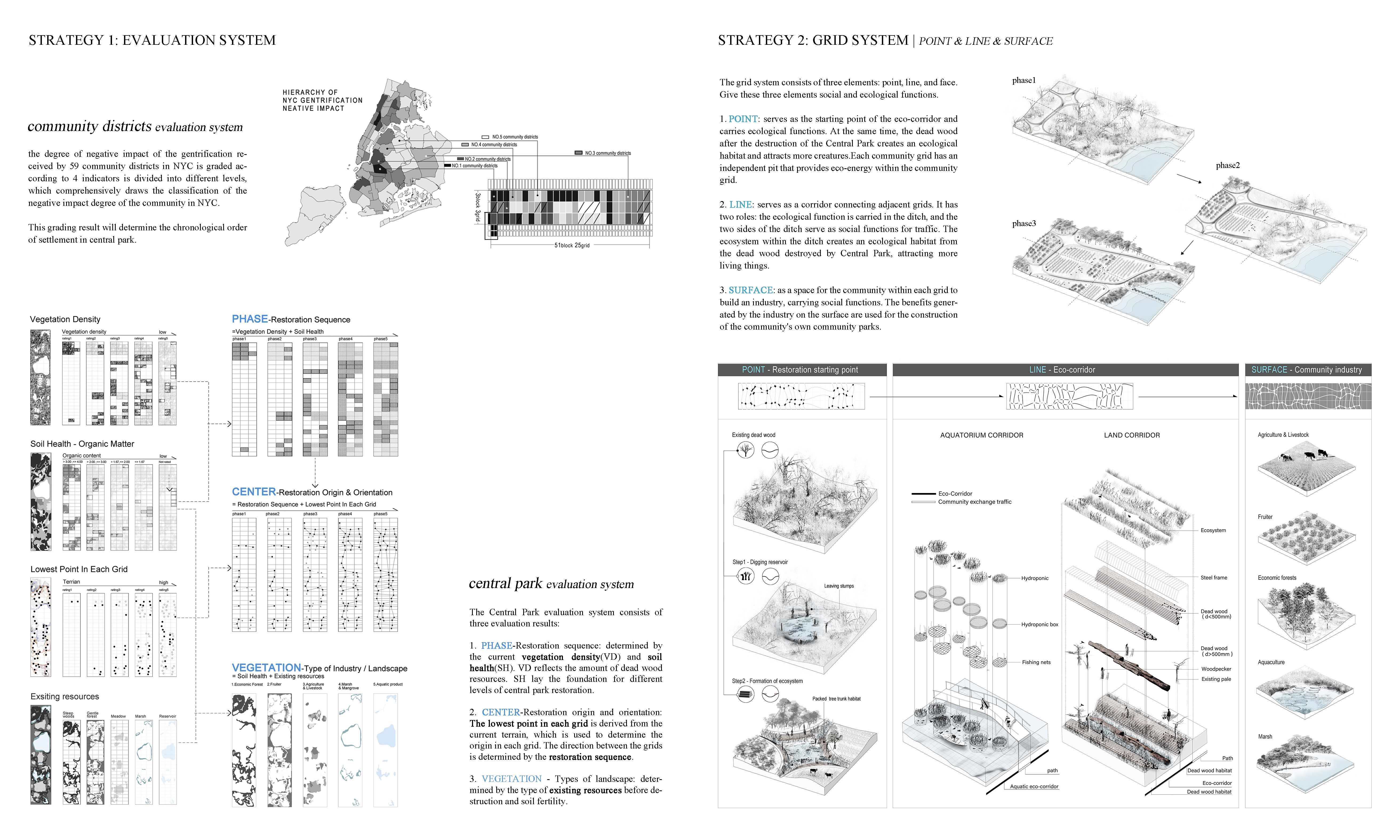
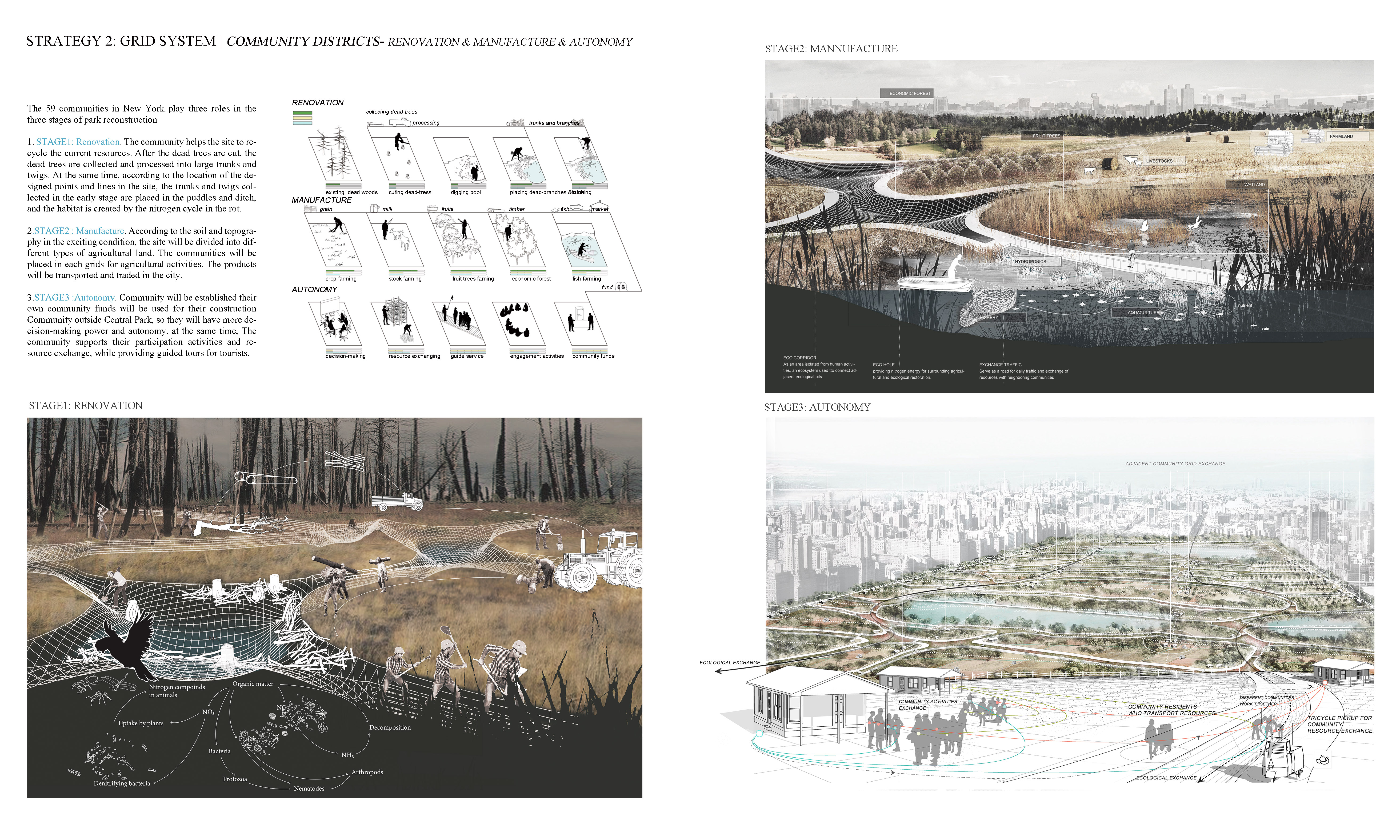
New York is the largest city in the United States and its
problem of gentrification is particularly serious. When a community environment
which is relatively poor needs to be updated, it will have to introduce
external funds to do so. Following improvement, house prices and rental incomes
generally increase, but not all of the original community are able to afford to
live there and they may ultimately be displaced. A typical example of this
phenomenon is the High Line park. On the other hand, many urban parks in rich
areas receive large social donations for improvement of green spaces. In
summary, there is an uneven distribution of green space construction funds and
a mismatch between residents’ income and expenditure on public space.
We believe that eco-gentrification is caused by environmental inequities. Low-income communities need fair access to green spaces, but they are also afraid of the adverse effects of eco-gentrification. In addition, communities may lack autonomy in the construction of community parks, and lack the ability to resist eco-gentrification. As a typical representative of high-end parks, Central Park has enough influence to respond to these issues. The concept we propose is to link Central Park with 59 communities in New York as the main force in the construction of Central Park, giving them access to funds raised through their Central Park activities that will allow them to improve green spaces in their own communities.
We believe that eco-gentrification is caused by environmental inequities. Low-income communities need fair access to green spaces, but they are also afraid of the adverse effects of eco-gentrification. In addition, communities may lack autonomy in the construction of community parks, and lack the ability to resist eco-gentrification. As a typical representative of high-end parks, Central Park has enough influence to respond to these issues. The concept we propose is to link Central Park with 59 communities in New York as the main force in the construction of Central Park, giving them access to funds raised through their Central Park activities that will allow them to improve green spaces in their own communities.

